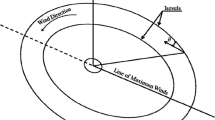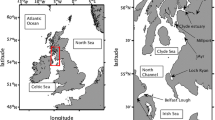Abstract
In the present paper a three-dimensional model has been used to calculate the vertical structure of the current generated by typhoon surge. The aim of this work is to obtain support for the depth-averaged model, which is based upon two basic assumptions. One of them is that the current has a negligible vertical structure and the other is that the velocity veering angle is small. Our results show that, in most of the real storm surge cases, these two assumptions are quite good approximations of the real situation, especially when water is shallow, and the locations are near the shore. These features are usually encountered in the real storm surges with which we are concerned. Therefore, we can expect that the two-dimensional depth-averaged model will give satisfactory results. The experiments carried out by using a straight coastline and uniform depth give vertical structures which are compatible with the conclusions previously reached by other authors.
Similar content being viewed by others
References
Feng Shizuo, 1977. A three-dimensional nonlinear mode of tides.Scientia Sinica 20 (4): 435–446.
Heaps, N. S., 1967. A two-dimensional numerical sea model.Phil. Trans. R. Soc. London A (265): 93–137.
Heaps, N. S., 1971. On the numerical solution of the three-dimensional hydrodynamical equations for tides and storm surges.Mem. Soc. r. Sci. Liege, Ser. 6 (2): 143–180.
Heaps, N. S., 1973. Three-dimensional numerical model of the Irish Sea,Geophys. J. R. Astr. Soc. 35: 99–120.
Hidaka, K., 1954. A contribution to the theory of upwelling and coastal currents.Tras. Amer. Geophy. Un. 35 (3): 431–444.
Johns, B., 1978. The modelling of tidal flow in a channel using a turbulence energy closure scheme,J. Phys. Oceanogr. 8: 1042–1049.
Johns, B., Sinha, P. C., Dube, S. K., Mohanty, U. C. and Rao, A. D., 1983. Simulation of storm surge using a three-dimensional model: an application to the 1977 Andhra cylone.Quart. J. R. Met. Soc. 109: 211–224.
Launder, B. E. and Spalding, D. B., 1972. Mathematical models of turbulence. Academic Press, London, 169pp.
Li Xinming and Wang Jingyong, 1965. Application of the potential theory and the method of image in the studies of drift and upwelling currents.Journal of Shandong College of Oceanology 1: 15–33. (in Chinese with English abstract)
Vager, G. B. and Kagan, B. A., 1971. Vertical structure and turbulent regime in a stratified boundary layer of a tidal flow.Izv. Akad. Nauk. SSSR, Fiz. Atmos. Oke an 7: 766–777.
Wang Jingyong, 1985. A comparative study of theoretical and numerical simulations of trapped waves induced by storm surges.Marine Sciences 9 (1): 1–6.
Author information
Authors and Affiliations
Rights and permissions
About this article
Cite this article
Jingyong, W. A numerical study of the vertical structure of typhoon surge currents. Chin. J. Ocean. Limnol. 3, 153–166 (1985). https://doi.org/10.1007/BF02906792
Issue Date:
DOI: https://doi.org/10.1007/BF02906792




